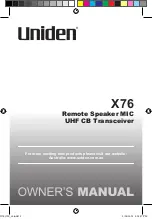
PRODUCT OVERVIEW
1-4
Part No. 001-4090-101/102
The unit is not hermetically sealed and should be mounted in a suitable enclosure when dust and/or a
corrosive atmosphere are anticipated. Physically, there are no external switches or adjustments. All operating
parameters are set using the INTRSS software program.
1.8 DIAGNOSTICS
Integra-H has sophisticated built-in diagnostics that may be transmitted automatically without interfering
with normal network operation. In addition, commands to generate test transmissions, etc., may be issued either
locally or remotely.
Diagnostic information takes one of two forms:
Online diagnostics
Information is automatically sent by each unit at the beginning of every data
transmission. Online diagnostics are available via the setup port or INTDIAG software.
Offline diagnostics
Information is sent by a specific unit in response to an inquiry made locally or from
another station. Off
1.9 FIRMWARE UPGRADES
The Integra-H firmware resides in flash EPROM and is designed to allow field upgrades.
Upgrades are done using a PC connected to the Integra-H but do not require opening the unit. Upgrades
require interaction with DRL’s Technical Service.
1.10 INSTALLATION
1.10.1 PROFESSIONAL INSTALLATION REQUIRED
The Integra-H complies with Part 15 of the FCC rules and must be professionally installed. Operation
must conform to the following conditions
l
This device may not cause interference
l
This device must accept any interference including interference that may cause undesired operation of
the device
The installer of this equipment must ensure the antenna is located or pointed such that it does not emit
RF field in excess of Health Canada limits for the general population; consult Safety Code 6 (available from
Health Canada)
.
1.10.2 ANTENNA CONNECTION
This equipment has been tested and approved with antennae having a maximum gain of 10 dB. Antennae
with a higher gain are strictly prohibited (regulations of Industry Canada). The required antenna impedance is 50
ohms. To reduce potential radio interference, the antenna type and its gain should be chosen to ensure the
equivalent isotropically radiated power (EIRP) is not more than required for successful communication.







































